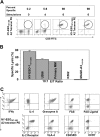NY-ESO-1 is highly expressed in poor-prognosis multiple myeloma and induces spontaneous humoral and cellular immune responses
- PMID: 15671442
- PMCID: PMC1895070
- DOI: 10.1182/blood-2004-09-3707
NY-ESO-1 is highly expressed in poor-prognosis multiple myeloma and induces spontaneous humoral and cellular immune responses
Abstract
The presence of a metaphase cytogenetic abnormality (CA) is the key negative predictor of outcome in patients with multiple myeloma (MM). Gene expression profiling (GEP) of such patients showed increased expression of NY-ESO-1 compared to patients with normal cytogenetics (60% versus 31%; P = .004). NY-ESO-1 was also highly expressed in relapsing MM especially patients with CA (100% versus 60.7%; P < .001). GEP findings were confirmed at the protein level by immunostaining of marrow biopsies for NY-ESO-1. We detected spontaneous NY-ESO-1-specific antibodies by enzyme-linked immunosorbent assay in 33% of patients with NY-ESO-1+ MM, especially in CA patients (9 of 13; 70%), but in none of the NY-ESO-1- patients with MM (n = 27) or healthy donors (n = 21). Spontaneous NY-ESO-1(157-165)-specific T cells (0.2%-0.6% of CD8+ T cells) were found in the peripheral blood of NY-ESO-1+ MM with HLA-A*0201/NY-ESO-1(157-165) tetramers. These NY-ESO-1-specific T cells, when expanded, killed primary MM cells (50% lysis, effector-target [E/T] ratio, 10:1). Our data demonstrate that NY-ESO-1 is frequently expressed in MM with CA and is capable of eliciting spontaneous humoral and T-cell immunity. The pool of NY-ESO-1-specific cytotoxic T cells expands easily on NY-ESO-1 peptide stimulation and is functionally active. NY-ESO-1 should therefore be an ideal tumor target antigen for immunotherapy of patients with poor-prognosis MM.
Figures



Similar articles
-
Functional autoantibodies against SSX-2 and NY-ESO-1 in multiple myeloma patients after allogeneic stem cell transplantation.Cancer Immunol Immunother. 2014 Nov;63(11):1151-62. doi: 10.1007/s00262-014-1588-x. Epub 2014 Jul 31. Cancer Immunol Immunother. 2014. PMID: 25078248 Free PMC article.
-
Antigen-specific in vitro expansion of functional redirected NY-ESO-1-specific human CD8+ T-cells in a cell-free system.Anticancer Res. 2013 Oct;33(10):4189-201. Anticancer Res. 2013. PMID: 24122982
-
Tumor-infiltrating NY-ESO-1-specific CD8+ T cells are negatively regulated by LAG-3 and PD-1 in human ovarian cancer.Proc Natl Acad Sci U S A. 2010 Apr 27;107(17):7875-80. doi: 10.1073/pnas.1003345107. Epub 2010 Apr 12. Proc Natl Acad Sci U S A. 2010. PMID: 20385810 Free PMC article.
-
NY-ESO-1 immunotherapy for multiple myeloma.Leuk Lymphoma. 2006 Oct;47(10):2037-48. doi: 10.1080/10428190600742292. Leuk Lymphoma. 2006. PMID: 17071474 Review.
-
NY-ESO-1 Based Immunotherapy of Cancer: Current Perspectives.Front Immunol. 2018 May 1;9:947. doi: 10.3389/fimmu.2018.00947. eCollection 2018. Front Immunol. 2018. PMID: 29770138 Free PMC article. Review.
Cited by
-
Engineered T cells: the promise and challenges of cancer immunotherapy.Nat Rev Cancer. 2016 Aug 23;16(9):566-81. doi: 10.1038/nrc.2016.97. Nat Rev Cancer. 2016. PMID: 27550819 Free PMC article. Review.
-
Advances and challenges in anti-cancer vaccines for multiple myeloma.Front Immunol. 2024 Aug 1;15:1411352. doi: 10.3389/fimmu.2024.1411352. eCollection 2024. Front Immunol. 2024. PMID: 39161773 Free PMC article. Review.
-
Cell-based immunotherapy approaches for multiple myeloma.Br J Cancer. 2019 Jan;120(1):38-44. doi: 10.1038/s41416-018-0346-9. Epub 2018 Dec 6. Br J Cancer. 2019. PMID: 30518815 Free PMC article. Review.
-
Safety and efficacy of letetresgene autoleucel alone or with pembrolizumab for relapsed/refractory multiple myeloma.Blood Adv. 2023 Apr 11;7(7):1168-1177. doi: 10.1182/bloodadvances.2022008460. Blood Adv. 2023. PMID: 36534160 Free PMC article.
-
Long-term safety and activity of NY-ESO-1 SPEAR T cells after autologous stem cell transplant for myeloma.Blood Adv. 2019 Jul 9;3(13):2022-2034. doi: 10.1182/bloodadvances.2019000194. Blood Adv. 2019. PMID: 31289029 Free PMC article.
References
-
- Scanlan MJ, Gordan JD, Williamson B, et al. Antigens recognized by autologous antibody in patients with renal-cell carcinoma. Int J Cancer. 1999;83: 456-464. - PubMed
-
- Obata Y, Takahashi T, Sakamoto J, et al. SEREX analysis of gastric cancer antigens. Cancer Chemother Pharmacol. 2000;46(suppl): S37-42. - PubMed
Publication types
MeSH terms
Substances
Grants and funding
LinkOut - more resources
Full Text Sources
Other Literature Sources
Medical
Research Materials

